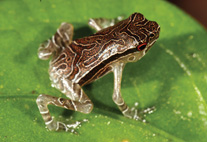Abstract
Bufonidae is one of the most diverse amphibian families. Its large-scale phylogenetic relationships are relatively well understood with the exception of few Neotropical genera that may have diverged early in the evolution of the family. One of those genera is Andinophryne, a poorly known group of three toad species distributed in the western slopes of the Andes of northern Ecuador and southern Colombia. Their phylogenetic position is unknown due to lack of genetic data. We estimated a new phylogeny (over 200 species) of the family Bufonidae based on DNA sequences of mitochondrial and nuclear genes to assess the phylogenetic position of Andinophryne based on recently collected specimens of A. colomai and A. olallai from Ecuador and Colombia. We also examined external and internal morphology of Andinophryne to explore its congruence with the new phylogeny. The mtDNA and nuclear phylogenies show that Andinophryne is embedded within Rhaebo, a genus that belongs to a large clade characterized by the presence parotoid glands. Morphological characters confirmed the affinity of Andinophryne to Rhaebo and a close relationship between Andinophryne colomai and Andinophryne olallai. Rhaebo was paraphyletic relative to Andinophryne and to solve this problem we synonymize Andinophryne under Rhaebo. We discuss putative morphological synapomorphies for Rhaebo including Andinophryne. We provide species accounts for R. atelopoides new comb., R. colomai new comb. and R. olallai new comb. including assessments of their conservation status. We suggest that the three species are Critically Endangered. Their altitudinal distribution and association with streams are characteristic of endangered Andean amphibians.

